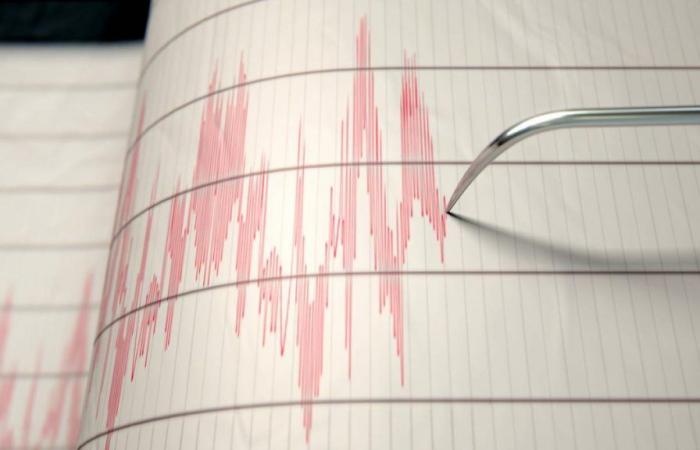
In the morning hours of this June 20, exactly at 11:19 local timea magnitude earthquake was recorded 3.2 in Uramita, Antioquia.
According to the Updated Bulletin 1 report, the event had a shallow depth, less 30 kilometers away, which means that its epicenter was located near the Earth’s surface.
This telluric movement was captured by the local seismological stations, generating alert among the population of the area and surroundings. Until now, No material damage or casualties have been reported. as a direct consequence of the earthquake.
Colombian Geological Survey
Photo:Colombian Geological Survey
The community is invited to report any perception or effect of the seismic event to local authorities. This helps gather vital information to assess the impact and response needed in the event of future events.
Local authorities and risk management bodies remain alert and vigilant to any further development. The population is recommended to remain calm and be prepared to follow safety instructions in case of aftershocks or other seismic events.
According to the SGC, in Colombia there are a total of 339 seismic stations that control the 24 hours a day and 7 days per week each telluric movement throughout the national territory. 206 stations are part of the National System Network and 133 are focused on volcano monitoring and the activity inside the craters.
The Colombian Geological Service answers frequently asked questions:
- What is the difference between magnitude and intensity?: Magnitude refers to the amount of energy released by the earthquake, a physical measurement based on the seismographic record. On the other hand, intensity is a qualitative measure that evaluates the effects of the earthquake on people, objects, buildings and the environment.
- What is the area of the country most affected by earthquakes?: In Colombia, earthquakes can occur in various regions, with variations according to their magnitude and depth. However, the area with the greatest notable seismic activity is the “Bucaramanga Seismic Nest”, located under the Mesa de Los Santos area in Santander, with Los Santos being the municipal seat with the most earthquakes associated with it.
- What is the area of the country least affected by earthquakes?: The Amazon and Orinoquía regions in Colombia are the least affected by earthquakes. Therefore, communities located in these areas experience less seismic activity compared to other regions of the country.
- What has been the largest earthquake in the country?: The most significant earthquake recorded in Colombia was that of January 31, 1906, located in the Pacific Ocean off the coasts of Esmeraldas (Ecuador) and Tumaco (Colombia). This event had an estimated moment magnitude (Mw) of 8.8, being the largest recorded with instruments and affecting Colombian territory.
With information from the SGC page*
What to do if you experience an earthquake?
If you experience an earthquake, it is important to stay calm and follow these recommendations to protect your life and that of your loved ones or the people who are with you at that moment.
- Keep calm: Try to stay calm and reassure those with you, especially if there are children or elderly people.
- Find a safe place: If you are inside a building, seek shelter under a sturdy table, desk, or solid piece of furniture. Protect your head and neck with your arms and stay away from windows, mirrors and falling objects.
- If outdoors: stay away from buildings, utility poles and trees. Find an open space and stay away from structures that could collapse.
- Don’t use elevators: Avoid using elevators during an earthquake, as you could become trapped. Use the stairs to evacuate the building once the shaking has passed.
- Stay alert: Pay attention to possible aftershocks, which are lower-intensity tremors that may occur after the mainshock.
- Execute your emergency plan: If you have an emergency plan in your home or workplace, follow it and make sure everyone in your family or colleagues knows what to do.
- After the earthquake: Once the shaking has stopped, check for injuries and provide help if necessary. If you are in a building, assess whether it is safe to remain there or whether you need to evacuate. Stay informed through local authorities and follow safety instructions.
What to do after an earthquake?
After a natural event like this, it is important to take some steps to ensure your safety and the safety of others.
- Assess the situation: Check if you are injured and seek medical assistance if necessary. Also check your surroundings for structural damage, such as cracks in walls, falling heavy objects, or gas leaks.
- Keep calm: Stay calm and help calm others, especially children and older people who may be scared.
- Turn off the fire: If there is a fire or risk of fire due to gas leaks, disconnect ignition sources and use fire extinguishers if safe to do so. If the fire is large or you cannot control it, evacuate the area and call the fire department.
- Evacuate if necessary: If the structure you are in is severely damaged and unsafe, evacuate the area and find a safer location. Use stairs instead of elevators and be careful of debris and obstacles on the way.
- Communicate with loved ones: If possible, contact family and friends to let them know you are safe and to check on your status.
- Listen to the authorities: Stay informed through radio, television or other media about the situation after the earthquake and follow the instructions of local authorities.
- Check the facilities: Once it is safe to do so, inspect your home or workplace for structural damage, gas, water or electrical leaks. If you find serious damage, do not attempt to repair it yourself and call the appropriate professionals to evaluate the situation.
- Prepare an emergency kit: If you don’t already have an emergency kit, prepare it with basic supplies such as water, non-perishable food, flashlight, batteries, first aid kit, and other items necessary to survive in the event of a prolonged emergency.
Attention lines
Emergency line: 123
Attention line: 195 District Contact Center
Bogotá Firefighters: Telephone Switch: +57 601 3 822 500
How to activate the Google seismic alert so that it warns you before it shakes?
- Open phone settings.
- Press ‘Safety & Emergency’ and then ‘Earthquake Alerts’.
- If you don’t find ‘Safety & Emergency’, press ‘Location’, then ‘Advanced’, then select ‘Earthquake Alerts’.
DANIELA GUTIERREZ MUNAR
LATEST NEWS EDITORIAL
#Colombia





